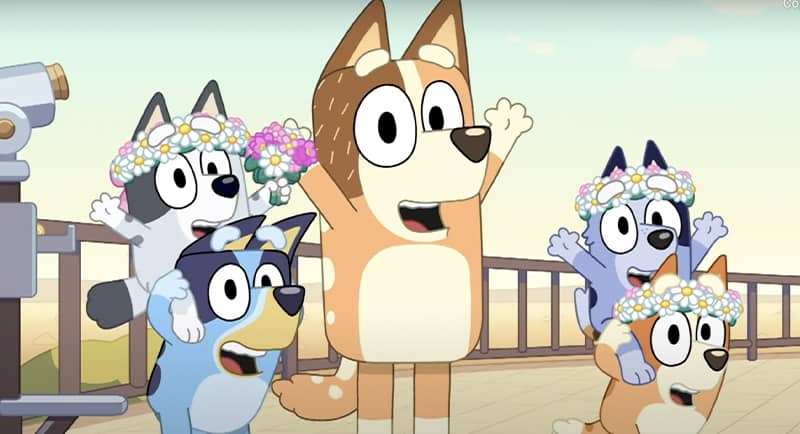By Liz Giuffre, Senior Lecturer in Communication, University of Technology Sydney
There is nothing like a wedding episode. Bluey’s first 28-minute special, The Sign, was the ultimate wedding television.
Full of family, and family-friendly, the wedding between Bluey’s godmother Frisky and uncle Radley was the sticky cake that held longer-than-average toddler attention spans and drew in broad audiences around and beyond Australia.
As Bluey creator Joe Brumm explained: “If you think of Bluey as a sitcom, they all have a wedding episode, so I fancied a crack. The idea lodged in my head and the story grew from there.”
Bluey’s huge international success is due its creators’ ambition to make more than just a kids’ show. By drawing on tropes of other television shows like wedding episodes, as well as developed character arcs and references to pop culture, it has become some of the best Australian storytelling of all time, of any genre.
This process of creating “easter eggs” – hidden references for the audience to look for – is a tactic a variety of television makers now use to reward audiences of all ages.
The Sign rewarded longtime viewers of Bluey. Aunty Brandy had been wanting a baby, and now seems to finally be pregnant. Nana and Grandpa Bob are doing a flossing dance they learned in series one. Bingo’s “big girl bark” has finally developed, and baby Socks is now able to talk. Instead of Nutbush City Limits or other standard wedding music, we had “dance mode” and everyone’s favourite fictional cartoon-within-a-cartoon theme song (and earworm), Catsquad.
The wedding march also built to include a guitar solo a little reminiscent of 80s Oz Rock – a nod to Angry Anderson’s Suddenly for Scott and Charlene, perhaps?
Why do we love a TV wedding?
Scott and Charlene walking down the aisle in Neighbours marked a generation of weddings for some of us. Kath Day and Cal Knight’s Pumpkin-style coach in Kath and Kim was the pinnacle for others. Both were huge ratings winners locally and internationally.
Audiences love TV weddings because they are spectacular. Amid the “flow” of broadcasting, wedding episodes draw us in by design. In the age of streaming, wedding episodes still have the potential to be appointment television.
From Joanie and Chachi in Happy Days to The Doctor and River Song in Doctor Who to David and Patrick in Schitt’s Creek, the appeal is the coming together of the couple – but also an excuse to draw together different groups around them.
Weddings can create big “television moments”, sometimes even overshadowing the couple at the centre. The multi-award winning second series of Phoebe Waller-Bridge’s Fleabag built its entire storyline (and excuse for new character of Andrew Scott’s “hot priest”) on the upcoming wedding of her father and godmother. Building to a “love is awful” speech by the priest, it was a plot device to underpin an ultimately doomed relationship.
Even when the characters aren’t entirely fictional, a “wedding episode” is almost always successful.
Prince Charles and Lady Diana Spencer broke broadcast records with their 1981 wedding. Even though the marriage itself only lasted 15 years, the 40th anniversary of the broadcast was marked with a “wedding of the century” documentary.
Reality, documentary and other forms of semi- or non-scripted television also use weddings to gain audiences: Married at First Sight is now in its 11th season in Australia.
Bluey’s wedding episode drew on events that many screen weddings deal with: a dramatic fight between the bride and groom; a sweet reunion; charming if not slightly sozzled family members and kids stealing the show with impossible cuteness. The supersized episode also provided some other big plot twists (was it a “sign” that the show might end for a while?), and promises of new beginnings.
An archive of weddings
The National Film and Sound Archive’s Australian Screen collection includes a huge range of wedding related pieces – both real and fictional.
Real weddings are captured in the 1914 silent clip “society wedding” of an unknown but clearly very upper-class couple and their family, clips from a 1950s Greek wedding reception in Canberra, and the 1973 ABC documentary series Chequerboard episode called It’s A Big Day In Any Girl’s Life.
The archive includes clips of beloved fictional weddings such as Muriel’s Wedding, and explorations of the value of marriage like in Brides of Christ.
Other worthy examples not yet in the archive are 2019’s Top End Wedding and Neighbours’ first same sex wedding for David and Aaron in 2018, officiated by Jemima Davies-Smythe (played by Magda Szubanski).
Surely The Sign is destined to join these forebears as part of the history of Australian screen weddings. As my children and I watched Bluey, we talked about my wedding to their dad and the weddings of family and friends. We talked about what makes a great story and having to wait to see an episode of television – something they are really not used to anymore.
During the episode we had a good laugh, we had a little cry, and a big dance – just like weddings “for real life”, as Bluey would say.
See Also: Listed for sale: Bluey’s iconic animated house
This article was first published in The Conversation, and can be read here.
